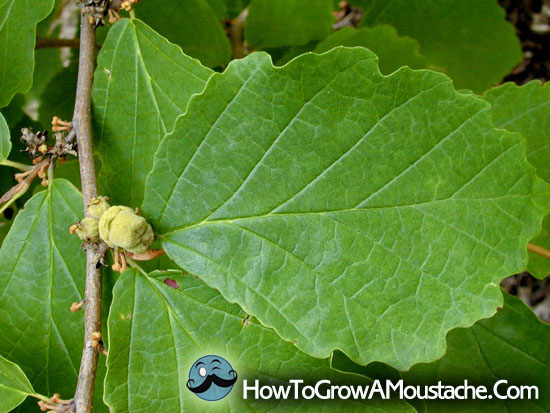Nothing beats a cool splash of Witch Hazel after a hot shave! The quick, natural astringent quality of the plant is undeniable, or is it?
A large percentage of the Witch Hazel sold today is actually more alcohol than Witch Hazel. The skin tingly astringent effect that most of us attribute to the Witch Hazel is none other than the alcohol evaporating on our skin!
Though the immediate cooling effect is quite refreshing, the long term use of alcohol on freshly shaven skin can be less than desirable. So, we here in the How to Grow a Moustache lab decided to by-pass the store bought stuff and concoct, or rather decoct, our own special blend of this magical stuff!
This turned out to be a fun little weekend project for us yielding great results. We encourage you to whip up your own batch and experience the noticeable difference that you can be proud of and state, “I made this myself” to your friends and family. As always, we keep your social standing and street credibility in mind. We are here to make you look good.
What you will need:
Equipment
1 Measuring Cup
1 Stainless Steel Pot (Preferably with a glass lid)
1 Clean Mason Jar
Coffee Filters or Cheese Cloth
Stove, Sous Vide or Crock-Pot
Ingredients
2 Cups Distilled Water
2 TBS Witch Hazel Bark (The fresher the better. Use up to a cup of this if possible to increase potency.)
2 TBS Witch Hazel Leaf (The bark would be enough but we are going for the synergistic angle and hell, we had the leaves!)
1 Dollop of Vitamin E (You can always pierce 3 Vitamin E gel caps with a pin and squirt that into the decoction too.)
6 Squirts of Grapefruit Seed Extract (This is optional for the Vitamin E should suffice on it’s own. Again, think synergy.)
Instructions:
Step 1: Place Bark and Leaves (crushed up) in pot and then add distilled water. Stir and allow to sit for 30 minutes to an hour before placing on stove top.
Step 2: When time is up, place pot on back burner of stove. Turn to simmer. Once it has reached a rolling boil, turn down heat slightly and place lid on pot. Keep an eye on it for the first 30 minutes to be sure it never exceeds a low rolling boil. Adjust heat as needed.
Step 3: Decoct Witch Hazel for 7-8 hours. Never leave stove totally unattended.
During this process the water will cook down and the volatile oils will be released into the liquid. You may also use this time to read our notes below on Witch hazel and some of the many uses for it!
Step 4: After 7-8 hours remove from heat. You can now choose to let the decoction sit for 45 minutes or filter hot. There seems to be two schools of thought among herbalists about this. Fact is, couldn’t hurt to just let it cool, plus if you are doing this with kids, it’s safer.
Step 5: Now strain through a coffee filter, cheese cloth, or a fine mesh colander. Strain 2-3 times. Note on color: Looks a little different than the stuff you keep in the medicine cabinet, aye? That’s because it is. This is a decoction, a different process than distilling, which many herbalists claim is better. Do not confuse this for “Witch Hazel Water,” that’s another name for the hydrosol, which is a by-product of the distillation process and also, like distilled witch hazel, doesn’t contain tannin.
Step 6: Add six drops of Grapefruit Seed Extract (GSE), and a dollop of Vitamin E. These are added to extend the life of your Witch Hazel while adding their own skin saving qualities in the process.
Step 7: Recap the jar tightly and shake it up for a minute or two. Bravo! You now hold in your hand a good old fashioned mason jar full of Witch Hazel. Un-refrigerated, and kept in a cool dark place (under the sink), it should keep for a month. Refrigerated you can expect it to last for a little over two months. Regardless, once you start using it daily it will probably be gone in a couple weeks! Shake well before each use.
[youtube]t4D2nCraz90[/youtube]
“You must bring us… a shrubbery!” ~ Knights who say Ni
Witch Hazel: (Hamamelis virginiana) Other names include Amerika-Mansaku, Carpe, Chin-Lumei, Pistachier Noir, Spotted Alder, Snapping Hazelnut, Trilopo, Winter Bloom, Tobacco Wood, White Hazel and rather fittingly, Magician’s Wand.
Native American Names: Pisewa Tik (The Menominee), Pisii-Kiwus (The Menominee), Bwaote It (The Potawatomi), Paga Nimig (The Potawatomi), Nsakemizins (The Ojibwa, or Chippewa)
Origin: Witch hazel is native to the eastern half of North America
The origin of the name Witch Hazel is kind of foggy but it has been in the books since the 1540’s. It is most likely taken from the Old English words wych elm (from wican: to bend). Then again the name could derive from the Middle English wiche or wice for “lively” due to the fact that the Y-shaped branches were once and are still used for the ancient art of water dowsing, an ancient practice taught to early settlers by the Native Americans. Native Americans also preferred the branches of the shrub to build bows out of…so there we are getting back to bending. See what we mean?
Medicinal Uses: Witch hazel is very effective for its use on various skin problems. This is credited to it containing hamamelitannins, a unique tannin which is highly astringent. The leaves, bark, and twigs all contain various medicinal properties, the highest concentration is found in the bark. Various tinctures, extracts, decoctions, lotions, ointments, and poultices are applied externally to inflammations, burns, swelling, itching, insect bites and stings, bruises, abrasions, poison ivy, diaper rash, eczema, muscle aches, broken capillaries, bleeding gums, varicose veins, tumors, cysts, and hemorrhoids, and to cuts and wounds to stop bleeding and prevent infection. Thoroughly diluted, the decoction can be applied to inflammations of the eye. Internally, the decoction has been used for internal bleeding, colds, coughs, asthma, fevers, diarrhea, dysentery, colitis, catarrh, sore throats, cholera, varicose veins, prolapsed organs, and heavy menstrual flow, and to restore the uterus after miscarriage, abortion, and childbirth.
 ABOUT DOUGLAS SMYTHE
ABOUT DOUGLAS SMYTHE
Founding member and contributing writer for “How to Grow a Moustache”, an innovative cutting edge blog dedicated to all things facial fur & wet shaving. His mission: Create facial awareness and use his super powers [read:moustache] for good. Contact Douglas: whiskers@howtogrowamoustache.com
Don’t forget to enter our Monthly Giveaway for a chance to win a Vintage Gillette and More! For more info visit Monthly Giveaway
[sign up in Right Sidebar]






